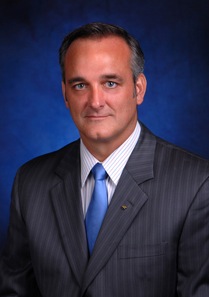Related Research Articles

Lidar is a method for determining ranges by targeting an object with a laser and measuring the time for the reflected light to return to the receiver. Lidar can also be used to make digital 3-D representations of areas on the earth's surface and ocean bottom, due to differences in laser return times, and by varying laser wavelengths. It has terrestrial, airborne, and mobile applications.

The Boeing YAL-1 Airborne Laser Testbed weapons system was a megawatt-class chemical oxygen iodine laser (COIL) mounted inside a modified military aircraft same as the Boeing 747-400F. It was primarily designed as a missile defense system to destroy tactical ballistic missiles (TBMs) while in boost phase. The aircraft was designated YAL-1A in 2004 by the U.S. Department of Defense.
The Canadian Space Agency is the national space agency of Canada, established in 1990 by the Canadian Space Agency Act. The agency is responsible to the minister of innovation, science, and economic development.

The Mars Polar Lander, also known as the Mars Surveyor '98 Lander, was a 290-kilogram robotic spacecraft lander launched by NASA on January 3, 1999, to study the soil and climate of Planum Australe, a region near the south pole on Mars. It formed part of the Mars Surveyor '98 mission. On December 3, 1999, however, after the descent phase was expected to be complete, the lander failed to reestablish communication with Earth. A post-mortem analysis determined the most likely cause of the mishap was premature termination of the engine firing prior to the lander touching the surface, causing it to strike the planet at a high velocity.

Phoenix is an uncrewed space probe that landed on the surface of Mars on May 25, 2008 and operated until November 2, 2008. Phoenix was operational on Mars for 157 sols. Its instruments were used to assess the local habitability and to research the history of water on Mars. The mission was part of the Mars Scout Program; its total cost was $420 million, including the cost of launch.

Steven Glenwood MacLean is a Canadian astronaut. He was the President of the Canadian Space Agency, from September 1, 2008 to February 1, 2013.

The Missile Defense Agency (MDA) is the section of the United States government's Department of Defense responsible for developing a layered defense against ballistic missiles. It had its origins in the Strategic Defense Initiative (SDI) which was established in 1983 by Ronald Reagan and which was headed by Lt. General James Alan Abrahamson. Under the Strategic Defense Initiative's Innovative Sciences and Technology Office headed by physicist and engineer Dr. James Ionson, the investment was predominantly made in basic research at national laboratories, universities, and in industry. These programs have continued to be key sources of funding for top research scientists in the fields of high-energy physics, advanced materials, supercomputing/computation, and many other critical science and engineering disciplines—funding which indirectly supports other research work by top scientists, and which was most politically viable to fund within the Military budget of the United States environment. It was renamed the Ballistic Missile Defense Organization in 1993, and then renamed the Missile Defense Agency in 2002. The current director is U.S. Navy Vice Admiral Jon A. Hill.
Teledyne DALSA is a Canadian company specializing in the design and manufacture of specialized electronic imaging components as well as specialized semiconductor fabrication. Teledyne DALSA is part of the Teledyne Imaging group, the leading-edge imaging companies aligned under the Teledyne umbrella.

Rex Geveden is the president and chief executive officer of BWX Technologies. Previously he was chief operating officer.
SPAR Aerospace was a Canadian aerospace company. It produced equipment for the Canadian Space Agency to be used in cooperation with NASA's Space Shuttle program, most notably the Canadarm, a remote manipulator system.

Robert D. Richards is a Canadian-born space entrepreneur. He is co-founder and CEO of Moon Express, Inc., a U.S. company partnered with NASA and developing robotic spacecraft to provide low cost access to the Moon for science, exploration and commerce. He is also the founder and former CEO of Odyssey Moon Limited, an Isle of Man based commercial lunar enterprise and the first official contender in the $30M Google Lunar X PRIZE competition. From 2002-2009 he was the founding Director of the Space Division at Optech Incorporated, providing advanced lidar systems for spacecraft operations and planetary exploration, including NASA's Mars Phoenix Lander and OSIRIS-REx missions.
Allan Ian Carswell, CM, FRSC is an internationally recognized leader in the field of laser radar (lidar) applications since the technology's beginning in the early 1960s. Carswell has been actively engaged in the study of the properties and applications of lasers and coherent optical frequency radiation since 1963. He was a member of the Plasma Physics Laboratory at the RCA Victor Research Laboratories in Montreal, Quebec, Canada, studying electromagnetic waves with ionized gas systems. In 1965 Carswell was appointed Director of the RCA Optical and Microwave Research Laboratory, and led the group there that developed the first CO
2 laser in Canada and the first Canadian commercial HeNe laser.
MDA Ltd. is a Canadian space technology company headquartered in Brampton, Ontario, Canada, that provides geointelligence, robotics & space operations, and satellite systems.

Northern Light was a concept mission for a robotic mission to Mars that would consist of a lander and a rover, being studied by a consortium of Canadian universities, companies and organisations. The primary contractor for the spacecraft was Thoth Technology Inc.
TriDAR, or Triangulation and LIDAR Automated Rendezvous and Docking, is a relative navigation vision system developed by Neptec Design Group and funded by the Canadian Space Agency and NASA. It provides guidance information that can be used to guide an unmanned vehicle during rendezvous and docking operations in space. TriDAR does not rely on any reference markers positioned on the target spacecraft. Instead, TriDAR relies on a laser based 3D sensor and a thermal imager. TriDAR's proprietary software uses the geometric information contained in successive 3D images to match against the known shape of the target object and calculate its position and orientation.

Avo Photonics, Inc. is a service corporation that designs, develops, and manufactures private-label opto-electronic products for the medical, industrial, defense, aerospace, and communication markets.
Savvas Chamberlain is a scientist, inventor, professor, and entrepreneur. In 1999, he was awarded a Distinguished Professor Emeritus of the University of Waterloo., where he remained for 25 years as a professor. During his time at the University of Waterloo, he invented many silicon image sensors, introduced new technology on MOSFET and Charge-coupled devices (CCDs) devices, and developed some fundamental theories.

Schiaparelli EDM was a failed Entry, Descent, and Landing Demonstrator Module (EDM) of the ExoMars programme—a joint mission of the European Space Agency (ESA) and the Russian space agency Roscosmos. It was built in Italy and was intended to test technology for future soft landings on the surface of Mars. It also had a limited but focused science payload that would have measured atmospheric electricity on Mars and local meteorological conditions.

Seafloor mapping, also called seabed imaging, is the measurement of water depth of a given body of water. Bathymetric measurements are conducted with various methods, from sonar and Lidar techniques to buoys and satellite altimetry. Various methods have advantages and disadvantages and the specific method used depends upon the scale of the area under study, financial means, desired measurement accuracy, and additional variables. Despite modern computer-based research, the ocean seabed in many locations is less measured than the topography of Mars.
The Buckeye system is an operational airborne surveying system that provides high-resolution spatial imagery over an area of interest to support military operations involved with intelligence, surveillance, and reconnaissance. Once mounted on a helicopter or an unmanned aerial vehicle (UAV), it incorporates visual information from a digital camera and elevation data from a Light Detection and Ranging (LIDAR) system to create a two and three-dimensional colored map with orthorectified, 4 to 6-inch resolution.
References
- ↑ "Teledyne Acquires Remaining Interest in Optech" (Press release). Toronto, Ontario. 30 April 2015.
- ↑ "Optech's Founder, Dr. Allan Carswell, honored with the John H. Chapman Award of Excellence by the Canadian Space Agency" (Press release). Toronto, Ontario: Optech Incorporated. 25 May 2006. Archived from the original on 8 February 2012. Retrieved 24 November 2012.CS1 maint: discouraged parameter (link)
- ↑ "Optech Space Division Director receives Honourary[sic] Doctorate" (Press release). Toronto, Ontario: Optech Incorporated. 2005-08-29. Retrieved 2012-11-24.CS1 maint: discouraged parameter (link)
- 1 2 3 "Partners in the Phoenix Mission". Canadian Space Agency. 2008-05-14.
- ↑ "PRESS RELEASE: Teledyne Increases Ownership Stake in Optech". Teledyne DALSA Inc. 2012-04-03.
- ↑ "Flight Hardware". Optech Incorporated. 2006. Retrieved 2012-11-24.CS1 maint: discouraged parameter (link)
- ↑ "Mars mission a giant leap for York's space scientists". Y-File, York University's News Source. York University. 2003-08-06.
- ↑ Optech (2007-07-31). "Optech Plays Key Role in NASA's Phoenix Mars Mission". Vaughan, Ontario: GISuser.com. Retrieved 2012-11-24.CS1 maint: discouraged parameter (link)